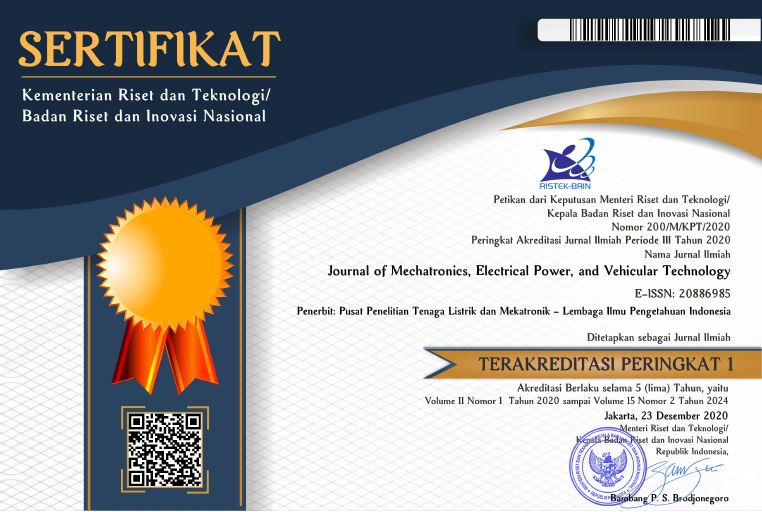The Performance of EEG-P300 Classification using Backpropagation Neural Networks
Abstract
Electroencephalogram (EEG) recordings signal provide an important function of brain-computer communication, but the accuracy of their classification is very limited in unforeseeable signal variations relating to artifacts. In this paper, we propose a classification method entailing time-series EEG-P300 signals using backpropagation neural networks to predict the qualitative properties of a subject’s mental tasks by extracting useful information from the highly multivariate non-invasive recordings of brain activity. To test the improvement in the EEG-P300 classification performance (i.e., classification accuracy and transfer rate) with the proposed method, comparative experiments were conducted using Bayesian Linear Discriminant Analysis (BLDA). Finally, the result of the experiment showed that the average of the classification accuracy was 97% and the maximum improvement of the average transfer rate is 42.4%, indicating the considerable potential of the using of EEG-P300 for the continuous classification of mental tasks.
Keywords
Full Text:
PDFReferences
E. Donchin, K. M. Spencer, and R. Wijesinghe. The mental prosthesis: Assessing the speed of a P300-based brain–computer interface. IEEE Trans. Rehabil. Eng., 2000, 8(2): 174-179.
P. Jezzard, P. M. Matthews, and S. M. Smith. Functional MRI: An Introduction to the Methods[M]. Oxford University Press, 2001. crossref
M. Hamalainen, R. Hari, R. J. Ilmoniemi, J. Knuutila, and O. V. Lounasmaa. Magnetoencephalography - theory, instrumentation, and applications to noninvasive studies of the working human brain. Reviews of Modern Physics, 1993, 65(2): 413-497. crossref
B. E. Hillner, B. A. Siegel, D. Liu, A. F. Shields, I. F. Gareen, L. Hanna, S. H. Stine, and R. E. Coleman. Impact of positron emission tomography/computed tomography and positron emission tomography (pet) alone on expected management of patients with cancer: initial results from the national oncologic pet registry. Journal of Clinical Oncology, 2008, 26(13): 2155-2161. crossref
F. Jouret, S. Walrand, K. S. Parreira, P. J. Courtoy, S. Pauwels, O. Devuyst, and F. Jamar. Single photon emission-computed tomography (SPECT) for functional investigation of the proximal tubule in conscious mice. AJP - Renal Physiology, 2010, 298(2): 454-460. crossref
U. Hoffmann, J.-M. Vesin, and T. Ebrahimi. An efficient P300-based brain–computer interface for disabled subjects. Journal of Neuroscience Methods, 2008, 167(1): 115-125. crossref
E. Niedermeyer and F. L. Da Silva. Electroencephalography[M]. 5th Ed. Lippincott Williams & Wilkins, 2005.
E. M. Izhikevich. Dynamical Systems in Neuroscience: The Geometry of Excitability and Bursting[M]. The MIT Press, Cambridge, Massachusetts, London, England, 2007.
D. Huang, P. Lin, D.-Y. Fei, X. Chen, and O. Bai. Decoding human motor activity from EEG single trials for a discrete two-dimensional cursor control. Journal of Neural Engineering, 2009, 6(4): 046005. crossref
D. Liu, Z. Pang, and S. R. Lloyd. A neural network method for detection of obstructive sleep apnea and narcolepsy based on pupil size and EEG. IEEE Trans. Neural Netw., 2008, 19(2): 308-318.
F. Nijboer, E. W. Sellers, J. Mellinger, M. A. Jordan, T. Matuz, A. Furdea, S. Halder, U. Mochty, D. J. Krusienski, T. M. Vaughan, J. R. Wolpaw, N. Birbaumer, and A. Kubler. A P300-based brain-computer interface for people with amyotrophic lateral sclerosis. Clinical Neurophysiology, 2008, 119(8): 1909-1916. crossref
E. W. Sellers, D. J. Krusienski, D. J. McFarland, T. M. Vaughan, and J. R. Wolpaw. A P300 event-related potential brain–computer interface (BCI): The effects of matrix size and inter stimulus interval on performance. Biological Psychology, 2006, 73(3): 242-252.
B. O. Peters, G. Pfurtscheller, and H. Flyvbjerg. Automatic differentation of multichannel EEG signals. IEEE Trans. Biomed. Eng., 2001, 48(1): 111-116.
J. R. Wolpaw, N. Birbaumer, W. J. Heetderks, D. J. McFarland, P. H. Peckham, G. Schalk, E. Donchin, L. A. Quatrano, C. J. Robinson, and T. M. Vaughan. Brain–computer interface technology: a review of the first international meeting. IEEE Trans. Rehabil. Eng., 2000, 8(2): 164-173.
S. Sutton, M. Braren, E. R. John, and J. Zubin. Evoked Potential Correlates of Stimulus Uncertainty. Science, 1965, 150(700): 1187-1188. crossref
D. J. McFarland, W. A. Sarnacki, and J. R. Wolpaw. Brain-computer interface (BCI) operation: Optimizing information transfer rates. Biological Psychology, 2003, 63(3): 237-251. crossref
S. Jaiyen, C. Lursinsap, and S. Phimoltares. A very fast neural learning for classification using only new incoming datum. IEEE Trans. Neural Netw., 2010, 21(3): 1750-1761.
Y. Washizawa. Feature extraction using constrained approximation and suppression. IEEE Trans. Neural Netw., 2010, 21(2): 201-210.
S. Ozawa, A. Roy, and D. Roussinov. A multitask learning model for online pattern recognition. IEEE Trans. Neural Netw., 2009, 20(3): 430-445.
S.S. Ge, Y. Yang, and T.H. Lee. Hand gesture recognition and tracking based on distributed locally linear embedding. Image and Vision Computing, 2008, 26(12): 1607-1620. crossref
Y. Yang, S. S. Ge, T. H. Lee, and C. Wang. Facial expression recognition and tracking for intelligent human-robot interaction. Intelligent Service Robotics. 2008, 1(2): 143-157. crossref
D. Graupe. Princiles of artificial neural networks[M]. 2nd Ed. World Scientific Publishing Co. Pte. Ltd. vol. 6, 2007.
Article Metrics
Metrics powered by PLOS ALM
Refbacks
- There are currently no refbacks.
Copyright (c)




















